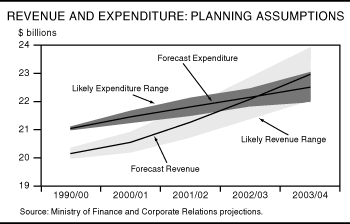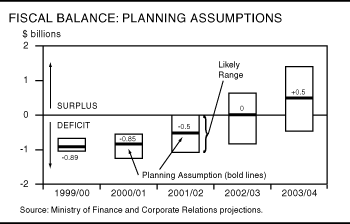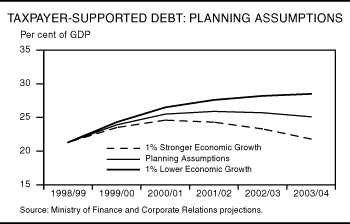FIVE-YEAR FISCAL PLANNING FRAMEWORK
Introduction
In preparing the 1999/00 budget, government undertook to publish additional information about revenue and expenditure projections, and to provide a longer-term planning framework. This report provides the government's primary economic and fiscal management assumptions for the five-year period 1999/00 to 2003/04.
Background
Between 1991/92 and 1997/98, the provincial government reduced its annual operating deficit from $2.5 billion to $152 million. Throughout this period, British Columbia's taxpayer-supported debt levels were among the lowest in the country.
The downturn in the economy in 1998 has created a new fiscal reality to which government must now respond. This topic box provides a five-year framework within which government will manage revenues, expenditures and debt levels.
Recent Economic Performance and Near-Term Outlook
The drop in key commodity prices associated with the Asian economic downturn has significantly changed the fiscal environment. Exports to Asia fell from $8.7 billion in 1997 to $6.6 billion in 1998. Economic activity was reduced and growth in the provincial revenue base fell along with declining export prices. With the effects of weak commodity markets expected to continue through 1999/00, there will be minimal near-term improvement in the province's revenue base and fiscal position.
Fiscal Policy Advice
The government has consulted widely and received advice on fiscal policy from many groups:
- The business community has recommended tax cuts of around $1.5 billion over a five-year period, financed in part by cuts to program spending and the adoption of new debt targets that correspond to the province's fiscal requirements.
- Other groups have urged that health and education should be protected, and that the role of government in an economic slowdown is to expand rather than contract its presence in the economy.
- There is recognition by most groups that have offered advice that, under any scenario, deficits are unavoidable in the short-term.
Fiscal Planning Principles
The following are the principles upon which the government will base its fiscal planning framework:
- The framework must be based on cautious assumptions, particularly in the early years when there is least room to make changes;
- The Consolidated Revenue Fund budget must be balanced within the five-year period;
- There should be continuous progress in each year of the plan;
- Health and education services to people must be protected; and
- Debt levels must remain affordable.
In addition to these principles, the government will move, over the five-year term, to adopting a summary account methodology as the primary fiscal reporting mechanism. The present Summary Account will be restructured to take account of issues raised by the Auditor General, and with advice from the advisory panel on government budget reporting.
The government will commit revenue in excess of the fiscal framework primarily to deficit/debt reduction. Public consultations will be held as to whether all excess revenues will go to debt reduction, or whether tax reductions should also be considered.
Components of the Five-Year Fiscal Planning Framework
1) Assumptions
The Fiscal Planning Framework is based on ranges for both revenues and expenditures that correspond to cautious assumptions.
To deal with the unavoidable margin of error associated with all projections, revenue and expenditure forecasts are presented as a series of "likely ranges". Corresponding to these forecast ranges, a deficit range has been established for each of the five years in the Planning Framework. A specific deficit target within the forecast range has been set for each year. This is the target toward which government will manage.
The upper and lower limits of the deficit range for each year represent the margins of the forecast range. The specific deficit target for 1999/00 has been set at the high end of the deficit range for that year, representing a significant degree of caution.
The forecast ranges are related both to the future performance of the economy, and to fiscal decisions of future governments. Because margins of error are additive over time, there is greater uncertainty about years further into the future.
2) Tax Reductions
The five-year framework incorporates the program of tax reductions already in place or announced in this budget. These are detailed in Reports C and D. By the time these measures are fully implemented in 2001, the government will have returned $1 billion in revenue to taxpayers on an annual basis.

3) Revenue Framework
Over the medium term, British Columbia's economic performance is forecast to improve along with a recovery in Asia. While commodity prices appear to be in long-run decline, current prices are also well below their long-run trend. Historical experience shows that commodity price recoveries can be quite large. Recovery in Asia and commodity prices are forecast to put revenues on a growth path averaging 2.6 per cent annually over the next five years (see chart).
4) Expenditure Framework
In the government's judgment, provincial expenditures for core services such as health, education and child care are at an appropriate level. To ensure a sustained improvement in the fiscal situation and guard against the possibility of lower-than-expected revenues, annual expenditure growth must be held within a range of 1.5 to 2.0 per cent, including allowances for population growth and inflation (see chart). This is slightly above the average rate of growth in the most recent three fiscal years, indicating that this is a manageable target, with the potential for additional savings to be made.

5) Operating (Consolidated Revenue Fund)
Deficit/Surplus Framework
With revenue growth averaging 2.6 per cent and expenditure growth 1.7 per cent annually, the operating deficit would be eliminated in 2002/03 (see chart). Faster revenue growth or smaller spending increases will advance this timetable. An operating surplus is achieved by the end of the plan, which should be sufficient to eliminate the Summary Account deficit.
6) Capital Expenditure Framework
Capital expenditures of the provincial government's funded agencies peak at $1.95 billion in the upcoming fiscal year (1999/00). This reflects the government's acceleration of already-planned school, hospital, road and other infrastructure projects to help stimulate economic activity and to take advantage of lower costs in a period when private construction has slowed. Over the following four years, capital expenditures are expected to decline as major projects are completed.

7) Taxpayer-Supported Debt
Taxpayer-supported debt represents the accumulated operating deficits of the provincial government, plus debts incurred to finance capital spending by Crown corporations and government-funded agencies.
Despite the downturn in the economy, debt remained in the planned range at the end of 1998/99. At 21.3 per cent of gross domestic product (see chart), taxpayer-supported debt at the end of 1998/99 will be among the lowest of the provinces. Estimates by the Toronto-Dominion Bank show the average debt/GDP ratio in the other nine provinces at 32.2 per cent in 1998/99. With about 9 cents of each revenue dollar going to debt service, British Columbia's debt places a lower burden on taxpayers here than in other provinces.
Over the five years of the Fiscal Planning Framework, a debt range of 22 per cent of GDP to 27 per cent has been set. This range allows for uncertainties in economic forecasting, and makes provision for the accelerated capital program.